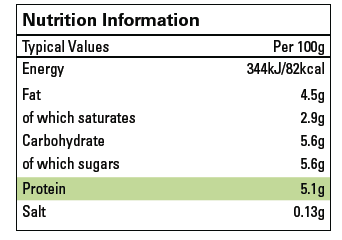For example, this yoghurt contains:

5.1g of protein per 100g. So, 100 ÷ 5.1 = 20g
Therefore, 20g is equal to 1 gram of protein.
A nutrition information panel will also state the amount of protein per serve/portion.
The table below shows how many grams of protein are in ONE portion of food.
If ONE portion of food contains 0.3g protein or less, then the amount of protein ONE portion provides, is considered protein- free. However, if your child eats more than ONE portion, this amount of food will contain greater than 0.3g protein, and so it will be counted towards the daily protein allowance.
| Protein Content (g/per portion) |
Grams of Protein |
| 0 - 0.3 |
Free (1 portion only) |
| 0.4 - 0.7 |
0.5 |
| 0.8 - 1.2 |
1 |
| 1.3 - 1.7 |
1.5 |
| 1.8 - 2.2 |
2 |
If you do not have the protein content per portion available, then you can still work out the amount of protein per portion of food that your child eats using the protein content for 100g.
See steps below:
- Multiply the protein content of food per 100g by the amount of the food eaten.
- Divide this number by 100 to give the grams of protein per portion of food.
If a child eats 20g of yoghurt:
5.1 (protein per 100g) x 20 (amount eaten)
÷ 100 = 1 gram of protein
Once your child is old enough, encourage them to read food labels and calculate their intake of protein at meals and snacks. Until then, at mealtimes it will be useful to get them familiar with knowing which foods contain protein and which ones are protein-free.
Understanding food labels will encourage independence and help to prevent your child always relying on you to do the work! Plenty of practice will increase their ability and confidence.
Always refer to the food label, ASIEM PKU Handbook and your dietitian for the most up-to-date nutritional information.
Read less

